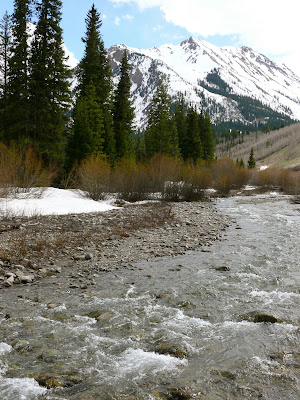That is the short answer. The long answer encompasses more...when it is spring or summer and there are no autumn colors, I am in search of colors in nature that are something other than green. The trees are green, the grass is green.....cool green dominates the landscape. So when I see reds, oranges, warm yellow-greens or purples, I am very inspired to do a painting or create that color in polymer.
 Castle Creek
Castle Creek
 Castle Creek
Castle CreekLater that afternoon, I found myself alongside Castle Creek near Aspen. I admired the rocks in the creek, and marveled how warm those rock colors were despite being under cold rushing water. The only blue in the water was a bit of sky reflection.
 Closeup photo of the colors in Castle Creek
Closeup photo of the colors in Castle Creek
 Closeup photo of the colors in Castle Creek
Closeup photo of the colors in Castle CreekThe colors in rocky mountain creeks are always a great inspiration to me. And despite the fact that spring has barely sprung in the high elevation of upper Castle Creek, the water colors are reminiscent of the autumn colors I like. The next day created a color palette I call "Trout Stream", based on the colors I found in the above abstract-like photo.

Trout Stream Color Sample Tiles
I have an idea what I am going to do with this collection of colors, now that I spent a good part of the day mixing them. I am going to work on some jewelry sized polymer mosaic pieces, and I'll post the results here.
In the meantime, check out Tish Collins' color palette of polymer mosaics. It's wonderful.













